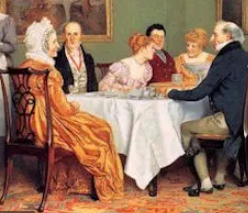We’ve heard the term, “Behind the green baize doors”, but what exactly does it mean? You hear this reference most often in regard to servants and in old books.
Baize was a sturdy green cloth attached to a swing door. The insulating fabric prevented noises from disturbing the individuals on either side:
The ‘Green Baize Door’ was the dividing line between the two domains, and trespassing beyond meant going into foreign territory. The ‘Green Baize Door’ was a feature of almost every substantial house. It was generally an ordinary framed door onto which was tacked a green baize cloth, usually with brass tacks. It was the universal signal of the dividing line between the two halves of the house.The Bull children would not be tolerated by the servants in the domestic part of the house unless they were working under supervision. This was like walking into somebody else’s house. The servants would normally use a different route to get to the various parts of the house, and would aim to be seen as little as possible. This was not because they were considered beneath notice: on the contrary, it was so that they could do their work uninterrupted by the requirement to exchange civilities. Houses evolved so that domestic staff could go about their task without interruption, not to ensure the privacy of the residents. They had none. –Borley Rectory and the Green-Baize Door, Domestic life at Borley Rectory, by Andrew Clarke , copyright 2002
The brass-headed tacks holding the cloth down could sometimes be arranged in a decorative design. The cloth not only deadened sound but also absorbed kitchen odors. Green baize doors became popular during the mid-Eighteenth century, so Jane Austen must have been aware of the practice, which was more and more used as the 19th century progressed. During Victorian times the practice of sound proofing doors with baize was quite common. The cloth could also be used to insulate nursery room doors, bedroom doors, and doors leading to studies or any place where sound needed to be muffled.
It was a time when housemaids were taught to turn their face to the wall if they should pass their employer on the stairs. For whose protection? one wonders. The era of Squire Allworthy and Sir Roger de Coverley had long passed, when relations between master and man were more informal. – The green baize door: social identity in Wodehouse; Part two – Allan Ramsay
Baize (or bayes), also known as a bocking flannel, was a coarse wool or cotton material, which had a felt-like texture:
“In Europe, baize was used mainly for case, cabinet and closet linings, as well as furniture coverings. Clothing baize was used for monk and nun habits as well as soldier’s uniforms. In the North American Native market, the term baize frequently alludes to inexpensive coarse broadcloth. – Wool Trade Cloth
Baize dates back to the 16th century, 1525 to be precise. A mid-17th century English ditty about the history of ale and beer brewing, mentions “bays”:
Hops, heresies, bays, and beer;
Came into England all in one year.
“Heresies refers to the Protestant Reformation, while bays is the Elizabethan spelling for baize. – Good English Ale
Baize was used in a number of ways, including as a protective cover for gaming tables, for the nap of the cloth increased friction, preventing cards from sliding and slowing billiard or snooker balls. The cloth is available in a variety of naps. Roman Catholic churches used red or green baize for altar cloth protectors, and the cloth was used in museum cases and desks as well.
As previously mentioned, baize was also used for clothing.
“I would recommend to you the Green Baize Gown, and if that will not answer, You recollect the Bear Skin.” Letter from Abigail Adams to John Adams, 3 December 1788
The site for Knox Family Clothing mentioned mid-18th century receipts for baize and bayes, as well as rattinet, armozeen, dowles, buff battinet, flannel, linen, silk, and velvet.
In Practical Cooking and Dinner Giving, published in 1876, Mary Foote Henderson recommends:
“Put a thick baize under the table-cloth. This is quite indispensable. It prevents noise, and the finest and handsomest table – linen looks comparatively thin and sleazy on a bare table.”

The Staircase Hall at Uppark. The red baize door leads to the servants' quarters. ©NTPL/Geoffrey Frosh
Red baize was also used as insulating material, as the decorative door at Uppark (image above) indicated. (National Treasure Hunt, National Trust Collections) In this advertisement for an 1808 Georgian house for sale, a red baize door to the inner lobby is featured. The red baize servant door providing access to the inner lobby and the kitchen, rear reception and breakfast room. 1808 house
More on the topic:













I think in Mansfield Park, they used Baize for the theatre curtain. I also think I rememebr Mrs. Norris taking it home with her.I hadn’t heard of baize coming in colors other than green before. Interesting post.
You are absolutely correct, Jenny. I had meant to place these quotes from Mansfield Park in my article, and am glad you mentioned this.
The play was never performed, for Sir Thomas arrived home unexpectedly, and
I’ve see billiards tables with red baize rather than green.
Our house is particularly noisy, and I’d been thinking of ways to dampen sound. Maybe I need to revive green baize! Now where to find some…
Excellent article! I was thinking the other night, as Branson paused before the green baize door at Downton Abbey, with his soup tureen full of nastiness, that not everyone would understand the significance of the green baize on that door. Now, thanks to your very detailed article, they do.
Regards,
Kat
Love your blog. You make the mundane of a household so much more interesting!
Interesting post, as always.
I wonder what colour door seperated the male servants from the maids – and who kept the keys?
Rumour has it that it was not infrequent for the master of the house and older male off-spring to have a copy of all the keys.
This was interesting (as usual); the beginning is contrary to everything I’ve ever read about the dividing purpose of the door. It had been my understanding that the door prevented “upstairs” from hearing/seeing the servants and most significantly masked cooking odors and etc. I had read servants were to be not seen and not heard by their “betters”. Thanks as usual for another intriguing and thought-provoking post.
There was a green baize door in my family home 60 years ago; the door is still there I think but I can’t remember whether or not the baize is still on it. The servants are long gone!
OED has:
‘baize, n. Etym: < French baies < Latin badius chestnut-coloured . .
1. a. A coarse woollen stuff, having a long nap, now used chiefly for linings, coverings, curtains, etc., in warmer countries for articles of clothing . . it was formerly, when made of finer and lighter texture, used as a clothing material in Britain also.
1578 in S. W. Beck Draper's Dict. (1882) 17 Blewe and blacke bayse.
. . 1667 S. Pepys Diary 24 Feb. (1974) VIII. 79 A cloak of Colchester bayze.
. . 1882 S. W. Beck Draper's Dict. 14 Bays, bayze, baize‥was first introduced here in 1561.
b. attrib.
. . 1853 Dickens Bleak House xli. 405 There is an inner baize door too.’
Very interesting and informative, Vic. I’ve wondered about this for for years; thank you for clearing it up!
Fantastic article about Highclere Castle. I definitely have to visit it during my next trip to England!
In case anybody is interested in the clothing men wear at Downton Abbey, you should take a look at Lord Grantham’s clothing as well as the Mess Dress article.
An old time crooner called Frankie Vaughn had a big hit in the UK (decades ago) with a record called “Green Door”, and his success was repeated years later by a guy called Shakin’ Stevens.
Totally irrelevant, but thought I’d share it.
Ralph and Ricki Lauren’s bedroom in their Bedford NY home is covered in deep blue baise and is beautiful.
We visited Jane Austen ‘s museum in Bath, England. Interesting wardrobe….
The 1752 case for the London Communion silver in my church is lined with its original purple baize. Baize came in all colors. Any modern coarse-weave cloth is acceptable.